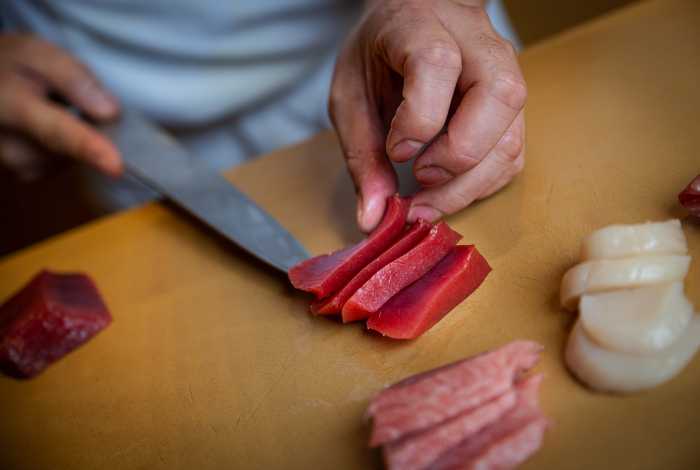Panettone, that sweet, towering Italian bread chock full of raisins and candied citron, is ubiquitous this time of year.
The bread takes a long time to rise, thanks to everything that’s in it. But if you are up for the baking challenge, let Jim Lahey be your guide.
The James Beard Award–winning baker behind Sullivan Street Bakery shares a version of his recipe for the home cook in his new cookbook, “The Sullivan Street Bakery Cookbook” ($35, W. W. Norton & Company).
Be forewarned: The stiff starter, or biga, takes about 24 hours to ferment; the panettone dough could take up to 48 hours.
After your hard work and patience, it’s key to protect the fragile panettone once it’s out of the oven, Lahey notes.
“To prevent it from collapsing as it cools, a panettone is traditionally hung upside down to dry, or ‘cure,’ ” Lahey writes. “So before you begin your own panettone, make sure you have metal or sturdy wood skewers and room somewhere in your home to cure the panettone for a few hours after it comes out of the oven.”
Once it’s ready, eat with prosecco or Champagne before or after a meal, “or even for breakfast the morning after,” Lahey advises.
Panettone
Yield: One 8- or 9-inch-tall, 7-inch-wide panettone
Equipment: A stand mixer fitted with the pastry paddle, one 9-inch paper panettone mold (often available online) or 7-inch round flat-bottomed baking dish such as a 1.75-quart Pyrex or ceramic soufflé dish, and two 12-inch long metal skewers
80 grams (1⁄2 cup) raisins, soaked in 1⁄4 cup very hot water for 20 minutes
100 grams (1⁄2 heaping cup) cubed candied citron (found in Italian markets; you can also use candied dried fruit in syrup — rinse the syrup off in running water and allow the fruit to dry before using)
113 grams (1 stick/8 tbsp.) unsalted butter, plus 14 grams (1 tbsp.) for the fruit and 14 grams (1 tbsp.) cold for baking, shaped into a square pat
300 grams (2 cups) unbleached all-purpose flour, plus flour for dusting
4 grams (1⁄2 tsp.) fine sea salt
125 grams (1⁄2 cup plus 2 tbsp.) water
115 grams (1⁄2 cup plus 2 tsp.) sugar
2 large eggs
5 grams (1 tsp.) honey
4 grams (1 tsp.) vanilla extract
Zest of 1⁄2 lemon (7 grams), finely chopped or grated
100 grams biga (see recipe below)
Stir the flour and salt together in a small bowl and set aside. In a small saucepan, melt 1 stick plus 1 tbsp. of the butter. Drain but do not dry the raisins. In a small bowl, combine the raisins and citron with 1 tbsp. of the melted butter and set aside.
Add the water to the rest of the melted butter in the saucepan and stir to combine. Heat the water and butter to 100 degrees, just above body temperature. Transfer the warm water and butter mixture to the bowl of a stand mixer fitted with a pastry paddle.
Add the sugar and mix on low speed until the sugar is dissolved. Mix in the eggs, honey, vanilla, and lemon zest on low speed until emulsified. Stop the mixer, add the biga, and continue to mix on low until it is mostly broken up. Add the flour and salt and mix for 2 or 3 minutes or until all the ingredients come together. Increase the speed to high and mix for 10 to 15 agonizingly long minutes, until the dough is sticky, bouncy, and webby — it will form long strings and strands — and pulls away from the sides of the bowl. You may hear your mixer begin to strain as the dough becomes clumped around the paddle; the dough may even ball up around the paddle. Stop the mixer when this happens; the dough is ready. Lower the mixing bowl and use a plastic dough scraper or rubber spatula to remove the dough from the paddle. Lift the bowl back up and pour the raisins and citron on the top of the dough.
Mix on low speed for 5 seconds. Stop the mixer and scrape the dough from the paddle. Mix for another 5 seconds on low speed. Stop the mixer, scrape the dough off the paddle, and repeat one or two times or until the raisins and citron are evenly distributed throughout the dough. This is a delicate operation; you want to incorporate the raisins and citron into the dough but also want to ensure that they are not mashed.
If you won’t need your mixing bowl for a few days, you could leave the dough in it and cover it loosely. Otherwise, transfer the dough to a 5-quart mixing bowl or other large container, cover, and allow to ferment. It will quadruple in size and is likely to reach the top of the bowl. Depending on the temperature in your kitchen and outside, it could take 15 to 48 hours. (The optimal temperature is 70 degrees; if your house is much hotter or cooler than that, try to find a small space near that temperature.) The texture will become extremely stringy and elastic, and poking into it with a finger will reveal a weblike structure. It will smell like vanilla and — thanks to the sugar-enhanced fermentation — alcohol.
Dust flour around the edges of the dough. Use a dough scraper or rubber spatula to gently get under the dough and scrape it away from the sides and bottom of the bowl. Turn the dough out onto a floured work surface and gently fold the corners of the dough into the center to make a ball. With floured hands, gently pick up and turn the dough over so the seam is down. Gently shape the dough into a round by tucking the sides down and under — taking extra care not to stretch the dough too much; if the dough has too much tension, the raisins and citron will begin to pop out from the dough (and subsequently burn as they cook). Be as careful as you can to avoid working flour into the dough — you want the flour there only to prevent the dough from sticking and tearing.
Gently lower the dough seam side down into a panettone mold sitting on a sheet pan. Cover the mold with a damp towel and allow to proof on the sheet pan until just shy of the top edge of the mold. It will take 3 to 7 hours.
Heat the oven to 350 degrees. Have a cold tablespoon-sized pat of butter on hand. Use a very sharp serrated knife to gently score the surface of the dough with a cross, from edge to edge, just barely cracking the surface of the dough. Place the tablespoon of cold butter in the center of the cross. (The butter helps the top of the dough stay moist and open up into triangles.) Put the panettone — still on the sheet pan, so that you don’t have to touch the mold and risk deflating the panettone — into the oven. Bake for about 55 minutes or until the outside of the panettone is beautifully browned and golden.
Immediately drive two long skewers through the paper mold — about ½ inch or less from the bottom of the mold. Very carefully pick up the panettone and hang it upside down by the skewers until it has cooled completely. If the panettone does not cool upside down, it will collapse. A panettone will last for several weeks to a month if kept in a sealed container, although it is rare that even a slice will last the space of an hour.
Recipes and photograph from The Sullivan Street Bakery Cookbook by Jim Lahey with Maya Joseph. Copyright © 2017 by Jim Lahey. Used with permission of W. W. Norton & Company, Inc. All rights reserved.
Jim’s biga
70 grams (scant 1⁄3 cup) room-temperature (65 to 70 degrees) water
10 grams (scant 1 tbsp.) refreshed fermented starter
100 grams (1⁄2 cup plus 3 tbsp.) unbleached all-purpose flour
0.1 gram (a tiny pinch) fine sea salt
Mix together the water and the refreshed starter in a small bowl. Add the flour and a few grains of salt. (Use just a tiny pinch, please — a bit of salt will speed up fermentation, but a heavy dose of salt will slow it down.) The dough will look lumpy, uneven, and small. Cover the bowl and prepare to wait about 24 hours for it to triple in size. Don’t be dismayed if nothing happens for the first 12 hours — it takes a while to get going, but once the fermentation starts, it will take off, and it is likely to grow more in the final 4 hours than it did in the first 16.
Poke at it and taste it — a fully fermented biga is pleasantly tangy with a fantastically airy, spongy, viscous structure. It will feel tacky, and it will taste and smell deliciously yeasty with a gentle smack of tartness — a bit like beer, but without any bitterness. At this point it’s ready to use. You may note color changes in the biga as the top layer dries out and oxidizes a bit; this is perfectly fine and to be expected.
Read more: Chef Wu’s Fusion Brisket Combines East-West Flavors




































